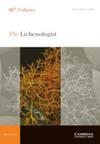PhyloKey:一种在复杂、物种丰富的属中快速、可靠地识别物种的新方法,为“非分子博物馆组学”提供了机会
IF 1.4
4区 生物学
Q4 MYCOLOGY
引用次数: 0
摘要
摘要基于RAxML软件包开发的基于形态学的系统发育分类方法,提出了一种新的识别工具PhyloKey。该方法采用一组既有分子数据又有形态数据的物种参考数据,计算一个分子参考树,将形态特征映射到树上,并使用最大似然(ML)和最大简约(MP)计算基于一致性与同质性水平的权重。只有形态数据已知的其他单元被分类到参考树中,计算替代位置的引导支持值。这里对这种方法进行了修改,使其成为一种识别工具,它使用与交互式密钥相同的字符编码方法。然而,在输入或选择字符时,不是通过渐进式过滤过程来识别单个样本,而是以批处理模式将查询样本分类到树中所有可能的替代物种,每个位置都接受一个bootstrap支持,所有替代位置都添加到100%。除了在对特征矩阵进行评分后,可以在短时间内同时识别大量样本之外,所有可能的替代识别都是显而易见的,并且可以根据其引导支持值进行评估。我们用担子苔藓属Cora来说明这种方法,最近发现它含有数百种。我们还展示了PhyloKey方法如何帮助重新研究植物标本馆样本,为这些收藏增加进一步的价值,并为“非分子博物馆组学”提供大量定量数据矩阵。我们的分析表明,根据参考树的性质和字符加权方案,PhyloKey识别物种的正确率低至50%。总的来说,分子参考树效果最好,但随机参考树的结果更一致,而形态参考树的效果较差。令人惊讶的是,即使是角色加权也会给出最好的结果,其次是简约加权,然后是最大可能性加权。本文章由计算机程序翻译,如有差异,请以英文原文为准。
PhyloKey: a novel method to rapidly and reliably identify species in complex, species-rich genera, and an opportunity for ‘non-molecular museomics’
Abstract We present a novel identification tool called PhyloKey , based on the method of morphology-based, phylogenetic binning developed within the software package RAxML. This method takes a reference data set of species for which both molecular and morphological data are available, computes a molecular reference tree, maps the morphological characters on the tree, and computes weights based on their level of consistency versus homoplasy using maximum likelihood (ML) and maximum parsimony (MP). Additional units for which only morphological data are known are then binned onto the reference tree, calculating bootstrap support values for alternative placements. This approach is modified here to work as an identification tool which uses the same character coding approach as interactive keys. However, rather than identifying individual samples through a progressive filtering process when entering or selecting characters, query samples are binned in batch mode to all possible alternative species in the tree, with each placement receiving a bootstrap support adding to 100% for all alternative placements. In addition to the fact that, after scoring a character matrix, a large number of specimens can be identified at once in short time, all possible alternative identifications are immediately apparent and can be evaluated based on their bootstrap support values. We illustrate this approach using the basidiolichen genus Cora , which was recently shown to contain hundreds of species. We also demonstrate how the PhyloKey approach can aid the restudying of herbarium samples, adding further value to these collections and contributing with large quantitative data matrices to ‘non-molecular museomics’. Our analysis showed that PhyloKey identifies species correctly with as low as 50% of the characters sampled, depending on the nature of the reference tree and the character weighting scheme. Overall, a molecular reference tree worked best, but a randomized reference tree gave more consistent results, whereas a morphological reference tree performed less well. Surprisingly, even character weighting gave the best results, followed by parsimony weighting and then maximum likelihood weighting.
求助全文
通过发布文献求助,成功后即可免费获取论文全文。
去求助
来源期刊

Lichenologist
生物-真菌学
CiteScore
2.90
自引率
14.30%
发文量
23
审稿时长
6.0 months
期刊介绍:
The Lichenologist is the premier scientific journal devoted exclusively to the study of lichens worldwide. As the leading forum for the dissemination of new concepts and topical reviews, The Lichenologist reaches more scientists concerned with the study of lichens and lichen symbionts than any other single journal. All aspects of lichenology are considered including systematics and phylogenetics; molecular biology; ultrastructure, anatomy and morphology; secondary chemistry, effects of pollutants and use as bioindicators; biogeography. In addition to standard length research papers, the journal also publishes Short Communications and Book Reviews. A monthly issue may occasionally be devoted to papers deriving from a symposium.
 求助内容:
求助内容: 应助结果提醒方式:
应助结果提醒方式:


